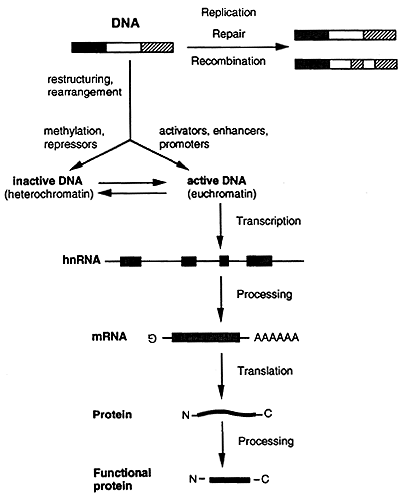
Nucleotides: Composition and Structure
Types and Functions of Nucleic Acids
There are two types of nucleic acids, deoxyribonucleic acid, DNA, and ribonucleic acid, RNA. DNA stores genetic information used for the synthesis of proteins including enzymes and is found in the nucleus and mitochondria. RNA has several functions and is found in the nucleus, cytosol and mitochondria. Messenger RNA (mRNA) carries genetic information obtained from DNA to sites that translate the information into a protein. Transfer RNA (tRNA) carries activated amino acids to sites where the amino acids are linked together to form polypeptides. Ribosomal RNA (rRNA) is a structural component of ribosomes, which serve as the sites for protein synthesis. Small nuclear RNA (snRNA) is a component of small nuclear ribonucleoprotein particles. These particles process heterogeneous RNA (hnRNA, the immature form of mRNA) into mature mRNA. In some viruses, HIV, influenza, polio, RNA functions as the storage house of genetic information.
Overview
The study of the replication and expression of genetic information involves a unidirectional flow from DNA to RNA to Protein:
DNA ------------->RNA------------->Protein
Our study of genetics will examine these processes in relation to the diagram shown below.

A Review of The Bases
Pyrimidines:
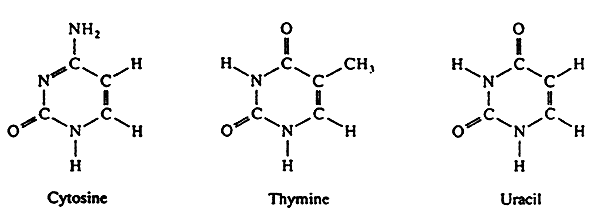
Purines:
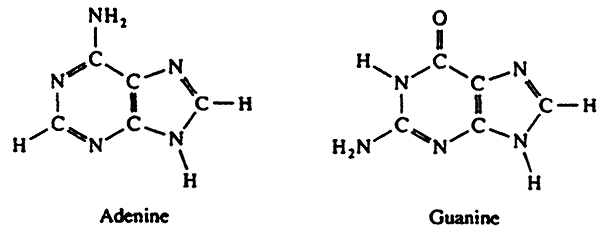
Nucleotide Composition
| Base | Ribonucleoside |
Ribonucleotide |
| (Base + Ribose) | (Base + Ribose + Phos.) | |
| Adenine(A) | Adenosine | Adenosine 5'-monophosphate(AMP) |
| Guanine(G) | Guanosine | Guanosine 5'-monophosphate(GMP) |
| Cytosine(C) | Cytidine | Cytidine 5'-monophosphate(CMP) |
| Uracil(U) | Uridine |
Uridine 5'-monophosphate(UMP) |
Ribose:

A "Ribonucleoside", A "Deoxyribonucleoside", A "Ribonucleotide"
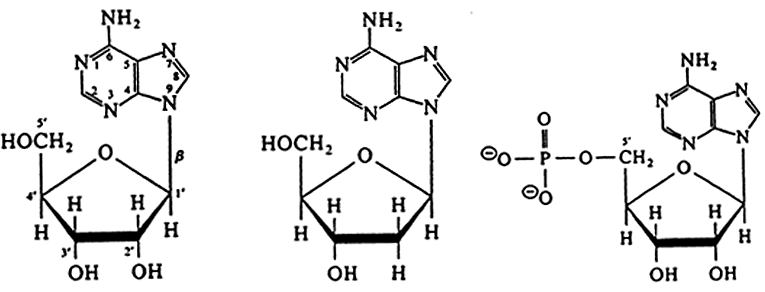
Nucleotide Derivatives:
Many biosynthetic reactions in carbohydrate metabolism require nucleotide derivatives.
i.e. Glucose-1-phosphate + ATP ----> ADP-glucose
Nucleotides Structure
Primary Structure of Nucleic Acids:
The sequence or order of the nucleotides defines the primary structure of DNA and RNA. The nucleotides of the polymer are linked by phosphodiester bonds connecting through the oxygen on the 5' carbon of one to the oxygen on the 3' carbon of another. The Oxygen and Nitrogen atoms in the backbone give DNA and RNA "polarity".

Secondary Structure of Nucleic Acids:
A purine base always pairs with a pyrimidine base or more specifically Guanosine (G) with Cytosine (C) and Adenine (A) with Thymine (T) or Uracil (U).

Notice the G-C pair has three hydrogen bonds while the A-T pair has two hydrogen bonds.
DNA: The secondary structure of DNA consists of two polynucleotide chains wrapped around one another to form a double helix. The orientation of the helix is usually right handed with the two chains running antiparallel to one another.
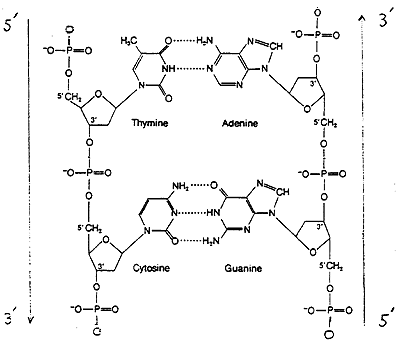
Complementarity:
The sequence of bases on each strand are arranged so that all of the bases on one strand pair with all of the bases on another strand, i.e. the number of guanosines always equals the number of cytosines and the number of adenines always equals the number of thymines.
There are two grooves, one major and one minor, on the double helix. Proteins and drugs interact with the functional groups on the bases that are exposed in the grooves.

The structural forms of DNA can differ in four aspects: the "handedness" (right or left), the length of the helix turn, the number of base pairs per turn, and the difference in size between the major and minor grooves. The most common structural form of DNA is the B-form.
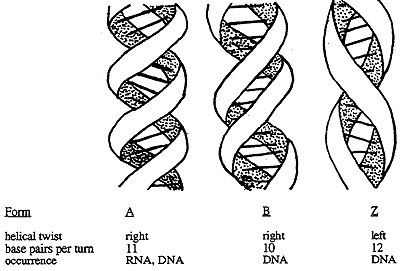
RNA:
The secondary structure of RNA consists of a single polynucleotide. RNA can fold so that base pairing occurs between complementary regions. RNA molecules often contain both single- and double-stranded regions. The strands are antiparallel and assume a helical shape. The helices are of the A-form (see above).
The structure of t (transfer) and r(ribosomal) RNA consists of multiple, single stranded, stem-loop structures. The stems consist of helices formed by base pairing of complementary regions within the RNA. The secondary structure of tRNA and rRNA are important for their biological functions, mRNA also assumes some degree of secondary structure but not to the same extent as tRNA and rRNA.

Chemical Modification:
Some of the bases in DNA and RNA can be chemically modified via methylation. Enzymes, similar to proteases, called exo- and endo-nucleases can cleave RNA and DNA. Exonucleases cleave nucleic acids from the ends. Endonucleases recognize specific sequences of duplex DNA and cleave at a specific site within or near the recognized sequence. The sequences that are recognized range from four to eight base pairs in length. The resulting fragments can be joined to other fragments to create new combinations of DNA sequences.

DNA can be denatured into single strands and renatured back into a double helix. Reversible denaturation is essential for the biological processes of replication and transcription; and for molecular biological techniques such as Southern blotting and polymerase chain reactions (PCR's). There are three ways to denature DNA: enzymatically, chemically or with heat. The denaturation of DNA via heat can be followed with a spectrophotometer set to a wavelength of 260 nm. Absorption increases with increasing heat breaking the hydrogen bonds that hold the strands together, unstacking and exposing the bases. This effect is called the hyperchromic effect. The temperature at which 50% of the DNA is denatured is called the melting temperature or Tm. Because GC base pairs are held together with three hydrogen bonds (AT have only two) the higher the percentage of GC base pairs the higher the Tm required to melt the DNA.
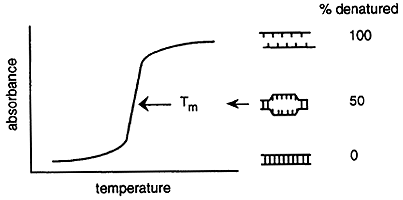
For renaturation to take place the two strands of DNA must contact one another to initiate base pairing. Once this happens the two strands quickly reassociate along their entire length. Several things influence renaturation: complexity, DNA concentration, cation concentration and temperature. Cations such as sodium, potassium and magnesium decrease the intermolecular repulsion of the negatively charged phosphate backbones of the two DNA strands. Renaturation will only occur if the temperature is below the Tm, however if the temperature is too low the rate of renaturation will decrease. Studies have shown that most of the mammalian renatures DNA consists of repetitive sequences with only about 5% being unique sequences encoding proteins and enzymes.
Hybridization can occur between complementary strands of nucleic acids derived from different sources. The double stranded nucleic acid that forms is a heteroduplex and the extent of heteroduplexes indicates homology between the two nucleic acid sources. For example, humans and mice mix with a very small fraction of the DNA renaturing but humans and chimpanzees give greater than 98% homology. DNA and RNA can also hybridize with one another to form heteroduplexes.
© Dr. Noel Sturm 2014